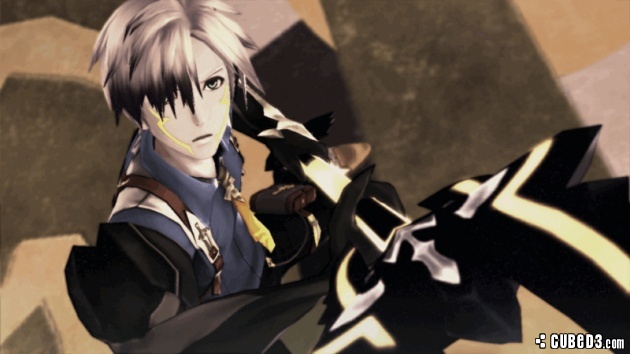Tales of Xillia 2 (PlayStation 3) Review
By SirLink  31.08.2014
31.08.2014

Sequels certainly aren't the norm for the Tales of series that - much like Final Fantasy - focuses on a number of games that have no direct connections to each other. While it's not classified as a main entry, the most well-known follow-up to a Tales of game would be Tales of Symphonia: Dawn of the New World for the Nintendo Wii. It had a number of unusual features for the franchise, such as monster raising, while omitting several Tales of traditions and was generally not as well received as the original Tales of Symphonia on the Nintendo GameCube by fans and critics alike.
Tales of Xillia 2 is in a similar situation, as it follows the events of the first game and features a number of unusual mechanics for the franchise. Unlike Tales of Symphonia: Dawn of the New World, though, it can hold its own against the best entries the series has to offer, namely Tales of Vesperia, Tales of Graces f and the original Tales of Xillia.
The story follows the new - and mostly silent - protagonist Ludger, who is accompanied by a kid named Elle and the cast of the original Tales of Xillia. While Ludger isn't a bad silent protagonist, he doesn't quite fit into a series that is all about character interaction. It's possible to pick his responses in numerous situations, but the fact that he doesn't actually say them out loud is a bit strange when compared to everyone else. Fortunately, the strong cast from the original game is back and better than ever. Initially, there's a bit of a feeling that they're just tagging along, but it becomes a lot better as the plot moves on.
The same could be said about the adventure in general. The early parts can prove to be quite confusing, even more so for fans that have played the previous game and are accustomed to certain Tales of traditions. It doesn't take too long for the plot to really kick off, however, and when it does, it turns into quite a heart-wrenching tale. In addition to the main chapters, there are several optional chapters for each member of the group that can be tackled between the primary ones, and provide more insight into the universe and a fair amount of extra character development. While they will appeal to fans of the previous game the most, they complement the main story extremely well and are definitely worth playing. Completing them also causes a number of bonus scenes to appear during the main chapters, which is a very nice touch indeed. Those who might be worried that they could miss any of them can rest easy, as they're conveniently marked on the world map.

To take advantage of the interactive story elements, Bandai Namco has implemented a relationship system between Ludger and each of the other characters. Understanding how they think is crucial to giving the correct answers, which is rewarded with extra skits and tomes that allow Ludger to use skills or Artes that would otherwise be exclusive to a specific party member. The bonus chapters in particular are a great way to improve the protagonist's relationships with the rest of the group. It's not a big feature, but its inclusion makes it a lot more entertaining to pick responses for him. This is particularly true for all the skits the game has to offer, which tend to touch upon some very weird and funny topics.
One rather unusual mechanic of Tales of Xillia 2 involves paying back a massive debt of 20 million Gald. Between every main chapter, a specific amount has to be paid back before it's possible to progress. The game encourages exploring a gradually increasing amount of optional areas - most of which are from the first game - in order to earn the money. It sounds tedious in theory, but it's actually not very hard or time-consuming to gather the required amount to progress. The bonus chapters also tend to be a good source of Gald, as some of them provide a rather large stack upon completion. Exploring is also made a lot more convenient by the ability to sprint that's obtained fairly early on. The best way to earn Gald, though, is by completing various jobs posted on a quest board, some of which also have small stories tied to them. In addition to regular jobs, there are a number of elite monsters that can be killed for a significant amount of Gald and points to rank up, which in turn unlocks more quests.
It's mandatory to keep Ludger in the active team, which is why he's a jack of all trades when it comes to his weapon arsenal. In addition to his standard dual blades, he can instantly switch to a mighty sledgehammer and even a pair of pistols for a total of three different play styles. They aren't just there for variety, either, as one weapon type can easily have the upper hand against specific enemies. Of course, it's also possible to control any other character for a much larger variety of play styles than Ludger can offer by himself.

Speaking of combat, the battles are based on the already great system found inTales of Xillia, but with additional refinements. The brilliant Linking system once again allows two characters to link up with each other in battle for a number of benefits. Perhaps one of the best improvements is that now every Arte can trigger a Linked Arte instead of it being limited to only a few different combinations. The catch is that these Linked Artes are only generic ones where the element and variety is decided by weapon choice and partner. Specific combinations still exist and are the stronger alternative, but the inclusion of generic ones to fill the gap is much appreciated. Another big improvement is how Mystic Artes are triggered. Instead of utilising a separate Arcane Arte during an Overlimit - that's triggered by filling the Linked Gauge and using Linked Artes - they can be used directly out of a Linked Arte, and it's even possible to select the one of the partner by holding down L1 alongside the X button.
The combat also has a touch of Tales of Graces f with its rewarding Power Combo system. Hitting an enemy with an element that it is weak to will activate a combo that temporarily increases all damage dealt to the monster while preventing it from counterattacking, which works on bosses, too. Using additional Artes of different elements in quick succession will increase the multiplier even further, which can also be used to significantly boost the damage of Mystic Artes by skilled players. While there is another new extra mechanic that can be used in battle, it is tied to the story in a way that discussing it would be a bit of a spoiler. That said, its inclusion is a welcome one, as it gives the combat a bit more personality to stand out when compared to its predecessor's.

The character progression system also saw some changes compared to the first game. The Lilium Orb was replaced by the Allium Orb, which can be equipped with elemental extractors. Elemental Ore - which can be obtained from enemies and found on the field - boosts the elements the currently equipped extractor has. For example, the extractor Droplet with a rate of one water element will turn ten Elemental Ore into ten points of water. There are many of these devices that can be obtained, with different growth rates and elemental combinations. They can be found in optional areas, too, making exploration a fair bit more rewarding. Amassing certain amounts of a particular element will unlock new Artes, upgrades for already learnt Artes and skills that can be equipped with skill points. Though it may sound very different, it essentially achieves the same thing as the old Lilium Orb system. That's not a bad thing, however, as it's far more important how natural and rewarding character progression feels. In this sense, the Allium Orb definitely works very well.
The biggest side quest in the game outside of the character chapters involves finding 100 cats across the world, which can then be used in a feature called Kitty Dispatch. Cats can be sent to previously visited areas to gather materials and other things, such as joke weapons that are a Tales of tradition of sorts. Finding them is another motivation to explore areas, although there are about two dozen Kitty Sighting quests that offer small hints concerning their whereabouts. Materials collected on the field and obtained from Kitty Dispatch are no longer required to level up shops. Instead, they are now used for various jobs on the quest board and crafting some more exotic equipment, while shop inventory is once again based on the location of the store.
In general, Tales of Xillia 2 contains a lot more of the little things that fans have come to love, such as costumes or decorations for the characters. These items can be mainly obtained by using Kitty Dispatch, completing character chapters and paying off Ludger's debt. Though their main use is purely aesthetical, some of them actually alter the music that's played during battle depending on which game the costume is based on.

Cubed3 Rating
Exceptional - Gold Award

Tales of Xillia 2 is quite unusual for a Tales of game and can be a bit confusing at first, but it doesn't take long for it to evolve into an experience that's very different and right up there with the best the franchise has to offer. While the combat is largely the same as its predecessor, some of its own ideas and mechanics work precisely because it is a sequel to an already established world and cast of main characters, which is the best approach Bandai Namco could have taken for a sequel in a series that largely consists of single, unrelated instalments. There is an encyclopaedia that sums up the events of the original Tales of Xillia, but it's still highly recommended - if not essential - to finish the first game for the best possible experience. With the massive improvements the franchise has seen in both gameplay and storytelling in recent entries, all eyes are on the upcoming Tales of Zestiria - that was announced to see a localisation in the same year as the Japanese release - to take the next big step forward.

![]() 9/10
9/10
![]() 7/10
(1 Votes)
7/10
(1 Votes)
 Out now
Out now  Out now
Out now  Out now
Out now  Out now
Out now Comments
Comments are currently disabled

 Sign In
Sign In Game Details
Game Details Subscribe to this topic
Subscribe to this topic Features
Features






 Top
Top

